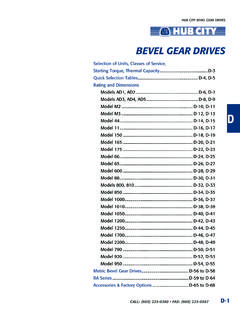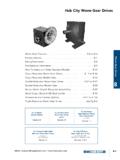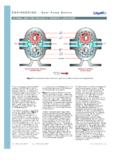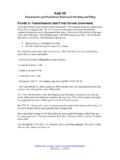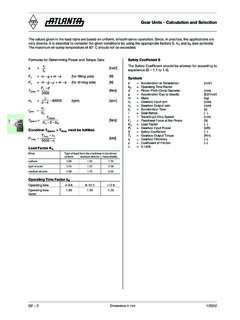Transcription of Gears and Gear Ratios
1 Gears and gear RatiosIntroduction to RoboticsGears What are they? Gears are wheels with teeth. Gears mesh together and make things turn. Gears are used to transfer motionor powerfrom used to transfer motionor powerfrom one moving part to another. Gears The PurposeGears are generally used for one of four different reasons: To reverse the direction of rotation To increase or decrease the speed of rotation To increase or decrease the speed of rotation To move rotational motion to a different axis To keep the rotation of two axis synchronized Gears The PurposeSports cars go fast (have speed) but cannot pull any weight. Big trucks can pull heavy loads (have power), but cannot (have power), but cannot go fast.
2 Gears cause this. Gears increase or decrease the power or speed, but you cannot generally speaking. Types of GearsSpur Gears are Gears in the same plane that move opposite of each other because they are meshed together. gear A is called the driver because this is turned by a motor. As gear A turns it meshes with gear B and it begins to turn as well. gear B is called gear B and it begins to turn as well. gear B is called the driven Details(Spur)The circle marked in red shows the outer limit of the teeth whilst the green circles are known as the pitch circles. The pitch circle of a gear is very important as it is used by engineers to determine the shape of the determine the shape of the teeth and the ratio between Gears ( Ratios will be explained later).
3 Thepitch of a gear is the distance between any point on one tooth and the same point on the next rootis the bottom part of a gear pitch point is the point where gear teeth actually make contact with each other as they of GearsBevel Gears can be used to change the direction of drive in a gear system by 90 degrees. A good example is seen 90 degrees. A good example is seen as the main mechanism for a hand drill. As the handle of the drill is turned in a vertical direction, the bevel Gears change the rotation of the chuck to a horizontal rotationTypes of GearsA rack and pinion Gears system looks quite unusual. However, it is still composed of two Gears .
4 The pinion is the normal round gear and the rack is straight or flat. The rack has teeth cut in it and they mesh with the teeth of the pinion pinion rotates and moves the rack in a straight line - another way of describing this is to say rotary motion changes to linear motion .Types of GearsThe arrangement of Gears seen is called a wormand wormwheel. The worm, which in this example is brown in color, only has one tooth but it is like a screw thread. The wormwheel, colored yellow, is like a normal gear wheel or spur gear . The worm always drives the worm wheel round, it is never the worm always drives the worm wheel round, it is never the opposite way round as the system tends to lock and SystemsCompound Gears are used in engines, workshop machines and in many other mechanical devices.
5 In the diagram, gear A is actually two Gears A is actually two Gears attached to each other and they rotate around the same centre. Sometimes compound Gears are used so that the final gear in a gear train rotates at the correct SystemsThis is a good example of a gear train . A gear train is usually made up of two or more Gears . The driver in this example is gear A . If a motor turns gear A in an A . If a motor turns gear A in an anticlockwise direction;Which direction does gear B turn ?Which direction does gear C turn ?Does gear C revolve faster or slower than gear A ? - explain your answer. ClockwiseCounter-ClockwiseSLOWER SMALLER gear TURNS A LARGER GEARGear SystemsSo far you have learned about driver Gears , driven Gears and gear trains.
6 An idler gear is another important gear . In the example opposite gear A turns in an anticlockwise direction and also gear C turns in an anticlockwise direction. The idler gear is used so that the rotation of the two important idler gear is used so that the rotation of the two important Gears is the GearsIt would be very difficult to draw Gears if you had to draw all the teeth every time you wanted every time you wanted to design a gear system. For this reason a gear can be represented by drawing two circles. CIRCLES OVERLAP WHERE TEETH MESHGear Ratio(Velocity Ratio)Many machines use Gears . A very good example is a bicycle which has Gears that make it easier to cycle, especially up hills.
7 Bicycles normally have a large gear wheel which has a pedal attached and a which has a pedal attached and a selection of gear wheels of different sizes, on the back wheel. When the pedal is revolved the chain pulls round the gear wheels at the Ratio(Velocity Ratio)The reason bicycles are easier to cycle up a hill when the Gears are changed is due to what is called gear Ratio (velocity ratio). gear ratio can be worked out in the form of numbers and examples are shown. Basically, the ratio is determined by the number of teeth on each gear wheel, the chain is ignored and does not enter the on each gear wheel, the chain is ignored and does not enter the :1216030 ==DrivingDrivenBut WHAT does this mean?
8 It means thatthe DRIVEN gear makes TWO rotations for every ONE rotation of the Driving Ratio - Examples1:3132575 ==DrivingDrivenWhat does this mean? For every 3rotations of the driving gear , the drivengear makes one Ratio - Examples1:4142080 ==DrivingDrivenWhat does this mean? For every 4 rotationsWhat does this mean? For every 4 rotationsof the driving gear , the driven gear makes 1 rotation. Working out RPMs (revolutions per minute)In the example shown, the DRIVER gear is larger than the DRIVEN gear . The general rule is - large to small gear means 'multiply' the velocity ratio by 'multiply' the velocity ratio by the rpm of the first gear .
9 Divide 60 teeth by 30 teeth to find the velocity ratio(1:2). Multiply this number (2) by the rpm (120). This gives an answer of 240rpmWorking out RPMs (revolutions per minute)In the example shown, the DRIVER gear is smaller than the DRIVEN gear . The general rule is - small to large gear means 'divide' the velocity ratio(3:1) by the velocity ratio(3:1) by the rpm of the first gear . Divide 75 teeth by 25 teeth to find the velocity ratio. divide the 60rpm by the velocity ration (3). The answer is out RPMs (revolutions per minute)If A revolves at 100 revs/min what is B ?(Remember small gear to large gear decreases revs)Compound gear RatiosWhen faced with three Gears the question can be broken down into two parts.
10 First work on Gears Aand B. When this has been solved work on Gears Band on Gears Band diagram shows a gear train composed of three Gears . gear A revolves at 60 revs/min in a clockwise direction. What is the output in revolutions per minute at gear C?In what direction does gear C revolve ?Compound gear RatiosGEAR AGEAR BGEAR C20 teeth60 teeth10 teeth1:3132060 ==DrivingDrivenThis means that for every THREE revolutions of gear A, gear B travels we are going from a SMALLER gear to a LARGER gear we DIVIDE the Rpms. min/203min/60revrev=Now find the gear ratio for B & :1616010 ==DrivingDrivenThis means for every ONE rotation of gear B, gear C makes SIX Is there an easier way?


